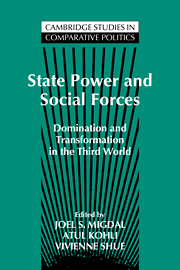Book contents
- Frontmatter
- Contents
- Preface
- List of contributors
- State Power and Social Forces
- Introduction: developing a state-in-society perspective
- PART I THEORETICAL AND METHODOLOGICAL CONSIDERATIONS
- 1 The state in society: an approach to struggles for domination
- PART II STATES: EMBEDDED IN SOCIETY
- PART III SOCIAL FORCES: ENGAGED WITH STATE POWER
- PART IV CONCLUSION
- Index
1 - The state in society: an approach to struggles for domination
Published online by Cambridge University Press: 05 June 2012
- Frontmatter
- Contents
- Preface
- List of contributors
- State Power and Social Forces
- Introduction: developing a state-in-society perspective
- PART I THEORETICAL AND METHODOLOGICAL CONSIDERATIONS
- 1 The state in society: an approach to struggles for domination
- PART II STATES: EMBEDDED IN SOCIETY
- PART III SOCIAL FORCES: ENGAGED WITH STATE POWER
- PART IV CONCLUSION
- Index
Summary
Ever since Thomas Hobbes wrote Leviathan in the seventeenth century, 150 years before the full blooming of capitalism, thinkers have grappled with the increasingly powerful state and its role in society. Following the Industrial Revolution, Karl Marx, Max Weber, Emile Durkheim, and many others devoted themselves to what Karl Polanyi would later call the great transformation. Like Hobbes, they too focused on the state, now in its relationship to the momentous social and economic changes overtaking European societies.
Some, such as the Hegelians, put the state – and the idea of the state – at the center of the social currents rushing through Europe. Others, including Marx, looked elsewhere for the source of historical change, notably to the organization of production. But even those who, like Marx, saw the primary motor of change outside the formal political realm felt called upon to address the notion of the transformative state. The new state was unquestionably a major component of life in the modern era and was understood by many as the driving force behind the astonishing changes of the time.
This statement holds true as much at the close of the twentieth century as in the latter decades of the nineteenth. Not surprisingly, then, the underlying questions dealt with in this volume echo the classical debates about major societal transformations and their relationship to the state. When and how have states been able to establish comprehensive political authority?
- Type
- Chapter
- Information
- State Power and Social ForcesDomination and Transformation in the Third World, pp. 7 - 34Publisher: Cambridge University PressPrint publication year: 1994
- 76
- Cited by

